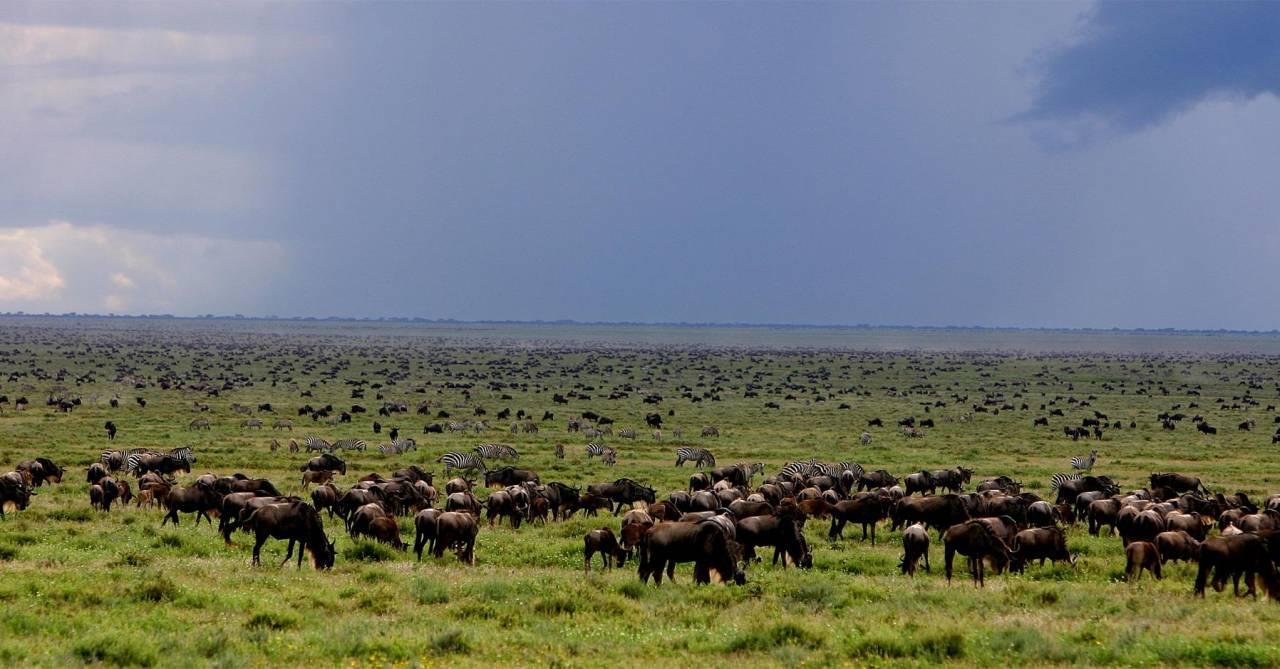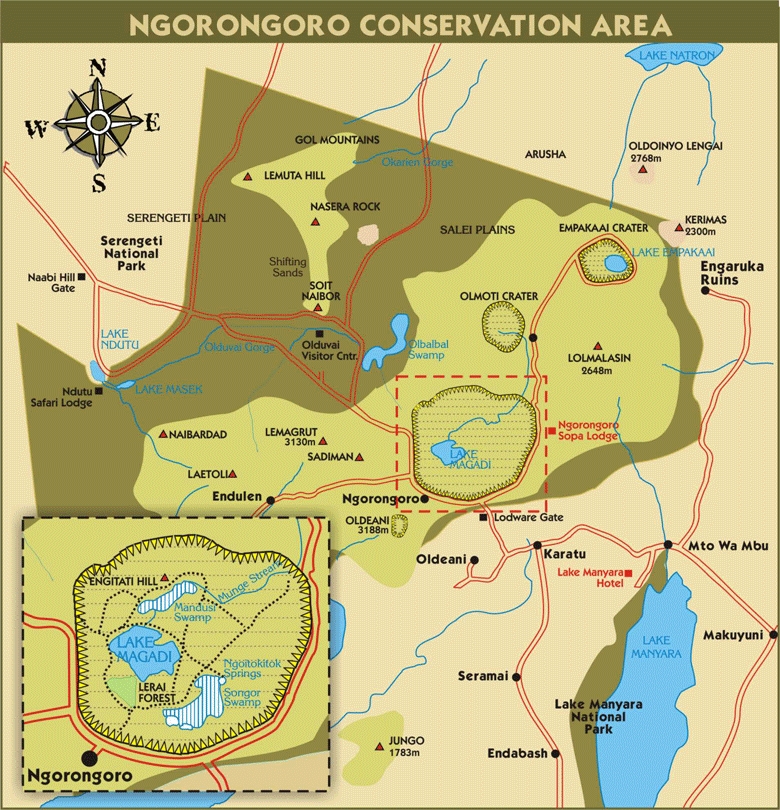When is the best time to visit the Ngorongoro Conservation Area?
The best time to visit the Ngorongoro Conservation area is when the migratory herds are here. The low-lying plains form part of the migratory route of the great migration. The herds move into the area in December and start to leave again in March/April. The best time to visit is thus December to March.
The best time to visit the highland section of the Ngorongoro Conservation Area is in the dry seasons, typically December to March and June to October. The highlands can be quite cold, covered in cloud and experience heavy rains in the other months.
Why should I visit Ngorongoro Conservation Area?
The great migration and volcanic craters
The best time to visit is when the herds are spread over the southern plains.

Which of the Big 5 can I see in the Ngorongoro Conservation area?
Plains areas: 5 of the Big 5. The Black Rhino is however very rare. Cheetah and the spotted hyena are common sights while the Wild Dog are present but very rare.
Highlands: 4 of the Big 5. Other than the Ngorongoro Crater, rhino are not present
Special animals/behavior in the Ngorongoro Conservation Area.
The annual wildebeest migration floods into the plains of the Ngorongoro Conservation area in December, preparing to give birth in February.
The Highlands offer the opportunity of hiking and walking amongst the wildlife of raw Africa.
What is the weather like in the Ngorongoro Conservation Area?
The low-lying areas of the Ngorongoro Conservation Area is classified as sub tropical. The temperature is mild during the day and cool at night. Temperatures from September to April are a couple degrees hotter than the rest of the year, but not by much.
The Highland areas can reach up to 3000m above sea level. These areas are colder and wetter and are often covered cloud and heavily forested.
Walking is a special treat in the Highland areas

About the Ngorongoro Conservation area
The Ngorongoro Conservations Area (NCA) is about 8300 km². It was established in 1959 as one of the world’s first multiple land use areas. A Multiple Land Use Areas is where wildlife and the semi-nomadic Maasai pastoralists coexist. It is possible to see wildlife and the herds of cattle and goats belonging to Maasai, side-by-side. The NCA includes the spectacular Ngorongoro Crater, the world’s largest caldera. Other than the Ngorongoro Crater, the Ngorongoro Conservation area encompasses the highlands, plains, savanna, woodlands and forests.
The famous Serengeti Plains refer in large part to the vast plains that fall in the Ngorongoro Conservation area. The area is mainly treeless with a few exceptions, namely the Ndutu Forest area. The Ndutu area forms the north-western part of the Ngorongoro Conservation area. It consistently offers the best wildlife viewing during the green season, Ndutu is strategically situated at the centre of the southern plains, is blanketed with a forest of acacia trees and is home to Lake Ndutu.
The NCA has global importance for biodiversity conservation due to the presence of globally threatened species, the density of wildlife inhabiting the area, and the annual migration of wildebeest, zebra, gazelles and other animals into the northern plains.
The Maasai people are a must for a visit to this area.

The Highlands and other craters
The Empakaai Crater
In the Highlands area of the Ngorongoro Crater Conservation Area (NCA), you will find the stunning but relatively unknown Empakaai Crater. It lies some 40km north-east of its famous neighbour, the Ngorongoro Crater. From the moment you arrive at Empakaai, you will be treated to splendid views of the crater as well as a glimpse of Oldoinyo Lengai, Tanzania’s most active volcano. It is famous for the thousands of pink flamingos that line the shores of the soda lake on the crater floor.
The Olmoti Crater
Olmoti Crater is a shallow, grassy hollow where Maasai pasture their cattle alongside eland, bushbuck, reedbuck and an occasional buffalo. From the south wall of the caldera, the Munge stream forms a waterfall, which plunges several hundred meters into the Ngorongoro crater to feed Lake Magadi. The northern flank of the Olmoti volcano offers good wildlife viewing with possibilities including buffalo, zebra, porcupine, hartebeest, bushbuck, hyena, leopard and elephant (at certain times of the year).
The Gol Mountains
To the north-eastern zone, the primeval Gol Mountains provide a surreal wilderness environment of stark, pink cliffs, enclosing the Angata Kiti pass. The pass forms a bottleneck for the annual Great Migration as they return to their ancestral breeding grounds in southern Serengeti and the Ndutu wilderness.
Nasera Rock rises 80 meters from the foot of the Gol Mountains. The monolithic Nasera Rock, the location of a Stone Age human shelter, was excavated by the Leakeys.
As well as the spectacular wildlife viewing, the NCA is also renowned for its extraordinary flora and fauna. The region is a botanist’s dream, showcasing a landscape of mountain forests, open grass plains and swampy marshland, each with a splendid variety of vegetation and fern species.
Maasai People Group
One of most important components of the NCA are the Maasai people who are part of the reason behind the Ngorongoro Conservation Area being established. It was an attempt to preserve the environment for the Maasai people who were moved from the Serengeti when it was proclaimed a national park.
Essentially nomadic people, they build temporary villages in circular homesteads called bomas. There are possibilities to visit a couple of these now, which have been opened up for tourists to explore. Here you can see how the huts are built in a strict pattern of order according to the chronological order of the wives, and experience what it must be like to rely on warmth and energy from a fire burning at the heart of a cattle dung dwelling with no chimney.
These proud cattle herding people have a great history as warriors, and even though they are no longer allowed to build villages inside, they continue to herd their cattle into the crater to graze and drink, regardless of the predators nearby.

Contact Us & Sitemap
Latest Articles
- African Safari Tours – Part 4 – Big 3 African Transfrontier ParksDecember 9, 2019 - 7:57 am
 African Safari Tours – Part 3 – Zimbabwe’s trio of safari must dos.November 18, 2019 - 7:07 am
African Safari Tours – Part 3 – Zimbabwe’s trio of safari must dos.November 18, 2019 - 7:07 am African Safari Tours – Part 2 – Unique Animals of AfricaNovember 14, 2019 - 6:52 am
African Safari Tours – Part 2 – Unique Animals of AfricaNovember 14, 2019 - 6:52 am African Safari Tours – Part 1November 13, 2019 - 5:27 am
African Safari Tours – Part 1November 13, 2019 - 5:27 am African ToursSeptember 26, 2019 - 11:25 am
African ToursSeptember 26, 2019 - 11:25 am


